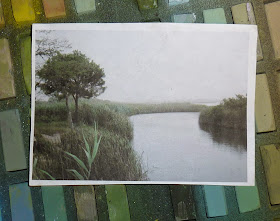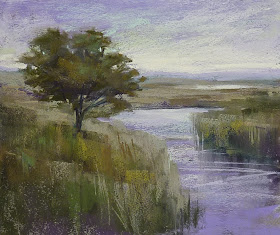Photos can inspire wonderful paintings. Photos can also lead to bad paintings. They are loaded with things that can create problems if they are copied into a painting. Sometimes they are obvious but sometimes they are sneaky. I am always on the lookout for these potential problems.
There are three things that I have found to cause the most problems in a painting. The photo below is a good example of all three!
 |
| Bad color, too sharp and needed elements |
- Photos don't always capture true and accurate colors. Often the typical point and shoot camera set on auto doesn't capture the subtleties of the colors in the landscape. Green is a typical example. Often photos of green landscapes show the greens to be the same color and value from the foreground to the background. If we copy this color it can lead to a flat landscape with no depth or atmospheric perspective. Photos also sometimes don't get proper exposure for the darks and lights in the same picture....this leads to overly light skies and shadows that are too dark. My photo has all of these issues...lack of true colors, no change in the greens, darks too dark and lights too light.
- Cameras record things as they are, not how we see them. The resulting photos often have detail and clarity everywhere. In reality our eyes focus on only one thing at a time the rest is out of focus (we don't even realize this unless we stop and focus on one thing and try to see what is around it) If we paint everything in crisp sharp detail it doesn't feel natural. If I want to have depth in my paintings I have to over ride the photo and make sure things in the distance have less detail than things in the foreground.
- Photos often include elements that don't translate well in a painting. There are often things that are better left out. I call these things 'half trees'. These are objects that appear unnaturally on the edges of a photo...maybe half or less of a tree or bush, or maybe an overhanging branch. I ask myself if the element needs to be in the painting (hold my thumb over it) If it does I make sure I put in more than half. Most of the time I leave it out. My photo has a branch coming in on the left and a big weed sticking up from the bottom. I don't need either element.
 |
| first version of the painting |
Painting Notes: 8x10 on gray canson. I started the painting with colors close to those in the photo. I found them to be too dull I didn't get as much depth as I wanted. I did leave out the branch and weed! I decided to spray the painting with workable fixative and add another layer of more intense colors.




Interesting post as I alway have problems working from photos.
ReplyDeleteWonderful article! I often have to take things like that into account when I look at photos.They can even distort proportions, curve verticals and create extra foreshortening beyond what's really there. Cameras are more of a shortcut - and also a medium in their own right.
ReplyDeleteWhen I was a kid my dad did his own black and white developing. He said that half of what makes a good photo happens in the darkroom from cropping to fiddling with the chemistry to get the best possible values in the image.
People think of cameras as accurate but they really aren't. They're as good as the skill of the person using them and for a painter half of it is just being a reminder, like a sketch, of what you really saw.
I may turn to the reference image library at WetCanvas for my big cats, but I also remember every zoo trip and time I ever saw one in person. Every arboretum where I saw tropical plants. Every trip to another part of the country even in childhood.
The myth that cameras see true is just that. Most people believe it and I am sometimes stunned at the paintings that get the compliment "looks just like a photo." They mean it looks accurate. I just laugh now, because sometimes it can be extremely loose and interpretive but they'll say that if it reads true. It can be as undetailed as I wanted, as painterly, as wild and colorful but if it sparks a memory then it Looks Just Like A Photo.
I figure that's just old propaganda from Eastman Kodak. A good realist painter can be far more accurate and an Impressionist gets whole other layers of truth in seeing. Not to disparage photography, but not everyone with a phone is Ansel Adams.
Useful reminders, good examples, and well written. Thanks for sharing this.
ReplyDeleteI only use my camera as a viewcatcher, and make several photos for reference (if necessary) at home, over and under exposed. Nevertheless a great post with a lovely painting.
ReplyDelete